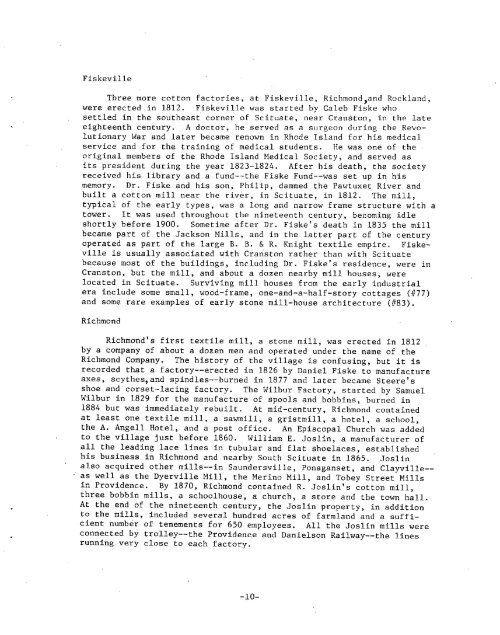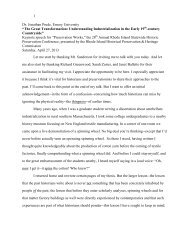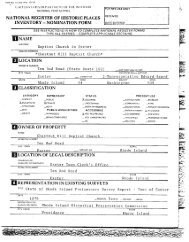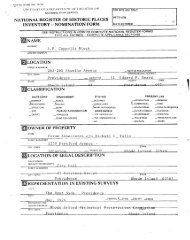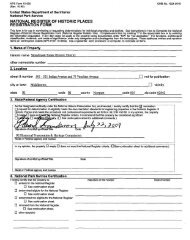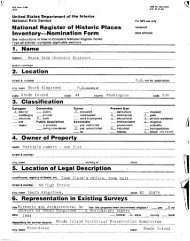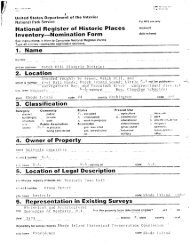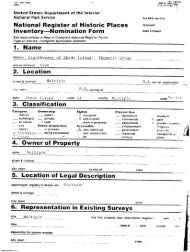Scituate - Rhode Island Historical Preservation & Heritage ...
Scituate - Rhode Island Historical Preservation & Heritage ...
Scituate - Rhode Island Historical Preservation & Heritage ...
You also want an ePaper? Increase the reach of your titles
YUMPU automatically turns print PDFs into web optimized ePapers that Google loves.
Fiskeville<br />
Three more cotton factories, at Fiskeville, Richmondand Rockland,<br />
were erected in 1812. Fiskeville was started by Caleb Fiske who<br />
settled in the southeast corner of <strong>Scituate</strong>, near Cranèton, in the late<br />
eighteenth century. A doctor, he served as a surgeon during the Revo<br />
lutionary War and later became renown in <strong>Rhode</strong> <strong>Island</strong> for his medical<br />
service and for the training of medical students. He was one of the<br />
original members of the <strong>Rhode</strong> <strong>Island</strong> Medical Society, and served as<br />
its president during the year 1823-1824. After his death, the society<br />
received his library and a fund--the Fiske Fund--was set up in his<br />
memory. Dr. Fiske and his son, Philip, dammed the Pawtuxet River and<br />
built a cotton mill near the river, in <strong>Scituate</strong>, in 1812. The mill,<br />
typical of the early types, was a long and narrow frame structure with a<br />
tower. It was used throughout the nineteenth century, becoming idle<br />
shortly before 1900. Sometime after Dr. Fiske’s death in 1835 the mill<br />
became part of the Jackson Mills, and in the latter part of the century<br />
operated as part of the large B. B. & R. Knight textile empire. Fiskeville<br />
is usually associated with Cranston rather than with <strong>Scituate</strong><br />
because most of the buildings, including Dr. Fiske’s residence, were in<br />
Cranston, but the mill, and about a dozen nearby mill houses, were<br />
located in <strong>Scituate</strong>. Surviving mill houses from the early industrial<br />
era include some small, wood-frame, one-and-a-half-story cottages #77<br />
and some rare examples of early stone mill-house architecture #83.<br />
Richmond<br />
Richmond’s first textile mill, a stone mill, was erected in 1812<br />
by a company of about a dozen men and operated under the name of the<br />
Richmond Company. The history of the village is confusing, but it is<br />
recorded that a factory--erected in 1826 by Daniel Fiske to manufacture<br />
axes, scythes,and spindles--burned in 1877 and later became Steere’s<br />
shoe and corset-lacing factory. The Wilbur Factory, started by Samuel<br />
Wilbur in 1829 for the manufacture of spools and bobbins, burned in<br />
1884 but was immediately rebuilt. At mid-century, Richmond contained<br />
at least one textile mill, a sawmill, a gristmill, a hotel, a school,<br />
the A. Angell Hotel, and a post office. An Episcopal Church was added<br />
to the village just before 1860. William E. Joslin, a manufacturer of<br />
all the leading lace lines in tubular and Elat shoelaces, established<br />
his business in Richmond and nearby South <strong>Scituate</strong> in 1865. Joslin<br />
also acquired other mills--in Saundersville, Ponaganset, and Clayville-as<br />
well as the Dyerville Mill, the Merino Mill, and Tobey Street Mills<br />
in Providence. By 1870, Richmond contained R. Joslin’s cotton mill,<br />
three bobbin mills, a schoolhouse, a church, a store and the town hail.<br />
At the end of the nineteenth century, the Joslin property, in addition<br />
to the mills, included several hundred acres of farmland and a suffi<br />
cient number of tenements for 650 employees. All the Joslin mills were<br />
connected by trolley--the Providence and Danielson Railway--the lines<br />
running very close to each factory.<br />
-10-


